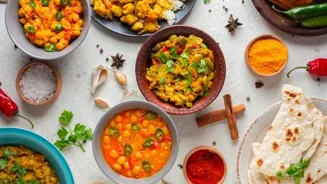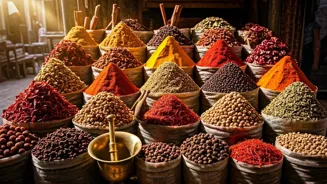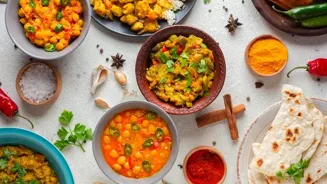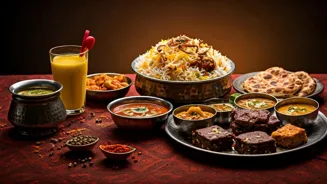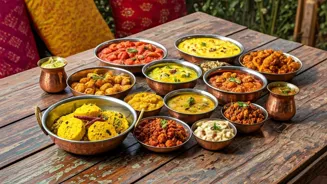Dive into the world of Indian seafood dishes from the coast! Explore iconic recipes with a vegetarian twist. Discover the essence of coastal cuisine without seafood consumption. Intrigued? Keep reading
to embark on a flavorful culinary journey!
India, a land of diverse cultures and landscapes, boasts a coastline stretching over 7,500 kilometers. This extensive coastline is not only a geographical feature but also a treasure trove of culinary delights, specifically when it comes to seafood.
The coastal regions of India, from Gujarat in the west to West Bengal in the east, each have their own unique approach to preparing seafood, influenced by local spices, cooking techniques, and traditions.
Forget fancy restaurants, the real magic happens in home kitchens and small seaside eateries where generations of cooks have perfected their recipes.
This article will explore some of the most iconic seafood dishes from the Indian coast, focusing on vegetarian alternatives inspired by the flavors of the sea, suitable for those who prefer to savor the essence of coastal cuisine without consuming seafood.
Exploring Goan cuisine through vegetarian Balchão dish
Let's begin our culinary journey in Goa, a land known for its vibrant culture and beautiful beaches. Goan cuisine is heavily influenced by Portuguese flavors, resulting in a delightful fusion of Indian and European tastes.
One of the most popular dishes, typically made with fish or prawns, is Balchão. For a vegetarian twist, try making a mushroom or paneer (Indian cheese) Balchão. Sauté mushrooms or paneer with onions, garlic, and a generous amount of Goan vinegar.
Add a blend of spices like cumin, coriander, turmeric, and red chili powder to mimic the original Balchão flavor profile. The vinegar provides the distinctive tangy taste, while the spices add warmth and depth.
This vegetarian version retains the essence of the Goan classic, offering a unique and flavorful experience. Serve it with rice or bread for a satisfying meal that captures the spirit of Goa without the seafood.
Exploring Kerala's diverse cuisine with Alleppey Vegetable Curry
Moving down the coast to Kerala, the "land of spices," we encounter another culinary paradise. Keralite cuisine is known for its use of coconut, curry leaves, and a variety of spices. Imagine a flavorful fish curry simmered in coconut milk and infused with local spices.
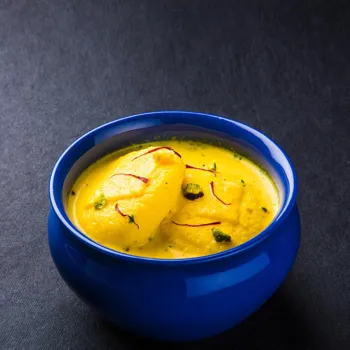
Now, picture a vegetable stew made with similar flavors, using ingredients like potatoes, cauliflower, and peas. This vegetarian "Alleppey Vegetable Curry" is a tribute to the Keralite seafood curries, offering a similar creamy texture and aromatic flavor.
In one version, simmer vegetables in coconut milk with ginger, garlic, green chilies, and curry leaves. Add a touch of turmeric and coriander powder for color and flavor. This dish is not only delicious but also a great source of nutrients.
Serve it with rice or appam (a type of pancake made from fermented rice batter) for an authentic Keralite experience reflecting the spirit of Kerala.
Explore Tamil Nadu's Chettinad cuisine with its rich, spicy flavors
Our next stop is Tamil Nadu, a state with a rich cultural heritage and a cuisine influenced by its history and geography. Tamil Nadu is famous for its Chettinad cuisine, which is known for its use of a wide range of spices and complex flavors.

Try a mushroom or vegetable Chettinad, inspired by its seafood version. The key to Chettinad dishes is the spice blend, which usually includes star anise, cinnamon, cloves, cardamom, and peppercorns. Roast and grind these spices to create a Chettinad masala (spice mix).
Sauté mushrooms (or a mix of vegetables) with onions, tomatoes, and the Chettinad masala. Cook until the vegetables are tender and the flavors have melded together. The complex spice blend gives the dish a unique and aromatic flavor.
Serve it with rice, dosa, or idli for a satisfying and flavorful meal.
Exploring West Bengal's iconic fish dish "Macher Jhol" & its veg version "Aloo Potol er Jhol."
Venturing further north along the eastern coast, we reach West Bengal, known for its freshwater fish dishes and rich Bengali flavors. One of the most iconic Bengali dishes typically made with fish is "Macher Jhol," a light and flavorful curry.
The unique flavors of West Bengal can be experienced by trying a vegetarian version of this classic dish called "Aloo Potol er Jhol." Aloo (potatoes) and potol (pointed gourd) are cooked in a light gravy flavored with ginger, cumin, and turmeric.
The dish is simple yet flavorful, highlighting the fresh flavors of the vegetables. The trick is to use high-quality ingredients and cook the vegetables until they are tender. Garnish with fresh coriander leaves before serving.
Aloo posto with coastal twist using seaweed and black salt
Aloo posto, a classic vegetarian dish from West Bengal, utilizes poppy seeds, a common ingredient in Bengali cuisine. While not directly inspired by traditional seafood recipes, its coastal adaptation includes ingredients reminiscent of the sea.
Imagine adding dried seaweed flakes or a pinch of black salt to the aloo posto. The seaweed flakes provide a subtle umami flavor, adding depth to the dish. Black salt, with its distinct sulfuric taste, mimics the subtle brininess of the sea.
These small additions elevate the dish, creating a unique flavor profile that captures the spirit of the coast. Serve it with rice for a comforting and satisfying meal.
Vegetarian coastal recipes offer a taste of Indian cuisine
These vegetarian alternatives inspired by the tastes of the sea offer a glimpse into the delicious coastline recipes of India. You can experience a lot about Indian cuisine without even having to eat the seafood by trying these.
Each dish is a story, a representation of local culture, traditions, and the generous gifts of nature. So, gather your ingredients, put on your apron, and get ready to embark on a culinary trip that will tantalize your taste buds and connect you to the rich and diverse flavors of coastal India.
Remember that cooking is a continuous journey, you can change the recipes to suit your tastes and to find new and exciting tastes. Don’t be afraid to experiment with the ingredients and techniques to create dishes that showcase your personal style and love for food.






